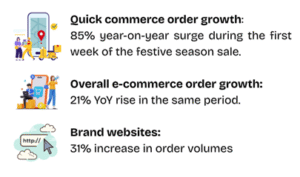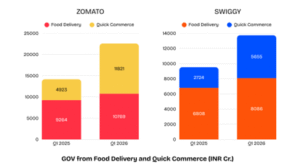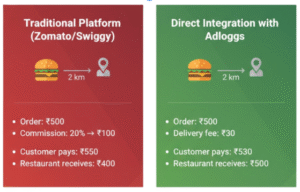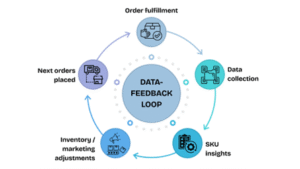As India lights up for the festive season, food and beverage brands brace for the surge. Every Diwali or Navratri, demand curves spike unpredictably as sweets fly off shelves, snack brands run out of stock, and logistics networks scramble to keep pace.
Yet, while consumer demand has become real-time, much of India’s distribution backbone still moves in batches. Bridging that gap is where the next wave of logistics innovation lies, creating a more connected and data-driven layer that helps brands reach consumers faster, smarter, and leaner.
When Festive Demand Outpaces Distribution

India’s festive e-commerce is projected to surpass ₹1.2 lakh crore this year, a 27% increase over last year, with quick commerce capturing up to 12% of festive online sales (Economic Times). Tier-II and Tier-III cities are driving this surge, as consumers upgrade appliances like water purifiers and microwaves, and shop for fashion items, proving that fast delivery is no longer just a metro phenomenon.
Yet, this explosive growth exposes a persistent gap: while consumers expect real-time delivery, traditional distribution networks operate on static forecasts and fixed routes. Inventory misalignment, rigid capacity, delayed demand signals, and fragmented last-mile delivery make it difficult for brands to capitalize on these fleeting windows of peak demand.
Enter Adloggs: Asset-Light Fulfilment for a Real-Time World
As India’s quick-commerce and on-demand economy accelerated, it became clear that the infrastructure powering it hadn’t kept pace. Local delivery networks were disjointed, fulfilment partners operated in silos, and brands lacked a single layer of visibility or control. Auxano recognised this gap early on and invested in the maiden round of Adloggs, a company building precisely that connective layer.
Adloggs sits at the intersection of technology, logistics, and brand enablement. Instead of owning trucks or warehouses, it builds an asset-light fulfillment network by aggregating hyper-local logistics partners, micro-warehouses, and dark stores.
Here’s how:
- Smart Delivery Orchestration: Adloggs’ platform streamlines delivery operations, providing real-time tracking and efficient
 coordination between businesses and delivery partners. This reduces operational overhead while enhancing service reliability.
coordination between businesses and delivery partners. This reduces operational overhead while enhancing service reliability. - Aggregation of Local Delivery Fleets: The platform connects businesses with smaller local delivery fleets, ranging from 5 to over 500 riders
- Cost efficiency: Adloggs’ delivery partners are paid per delivery based on distance, rather than through high commissions. For example, brands with strong demand like McDonald’s or KFC typically pay 20–30% commission via platforms like Zomato or Swiggy. By integrating directly with Adloggs, they can leverage the infrastructure and pay a per-trip fee of ₹30–₹60 instead, significantly reducing costs.
This approach allows brands to scale deliveries during high-demand periods, like the festive season. It also ensures brands can maintain speed, reliability, and visibility across their distribution networks, even when consumer demand is unpredictable or hyper-local.
The Quick-Commerce Connection

Quick-commerce has changed consumer expectations, as platforms like Blinkit, Swiggy Instamart, and Zepto have built micro-warehouses across cities, conditioning customers to expect instant accessibility.
For packaged food and beverage brands, this is both an opportunity and a challenge. They now have direct access to consumer data and faster delivery channels, but also less room for supply chain or inventory planning errors.
Adloggs enables these brands to plug into this ecosystem seamlessly:
- Aligning dispatch to real-time order signals
- Groups deliveries efficiently to help businesses prepare for increased demand
- Coordinating deliveries in real time and providing visibility across all active orders.
In effect, Adloggs becomes the connective tissue that allows a D2C brand to act like a quick-commerce native: fast, flexible, and data-informed.
Why the Timing Matters
Several forces are converging to make this model not just relevant, but essential:
- Seasonal volatility is rising. Consumer preferences shift rapidly, and festivals amplify these trends. FMCG sales witnessed a 15% spike this year during Navratri, with kirana stores stocking up to 18% more (Times of India). Static distribution systems simply can’t keep up.
- Margins are under pressure. Owning fleets or warehouses is expensive, especially for brands that see uneven, seasonal demand.
- Technology is maturing. Aggregator data, GPS tracking, and API integrations now make it possible to forecast and route in real time.
- Consumers expect immediacy. What started with food delivery has expanded to snacks, beverages, and even groceries, everything is now “on-demand.” Orders on Blinkit and Instamart reached Rs 64,000 crore in FY25, more than double the previous year (Economic Times)
In this environment, asset-light distribution enablement offers the agility brands need without the capital drag.
From Fulfilment to Intelligence
Distribution enablement isn’t just about moving goods faster, it’s about learning faster. Every fulfilled order adds to a feedback loop:
- Which SKUs sold most during a festival or sale?

- Which cities or pin codes outperformed expectations?
- How did promotions or influencer campaigns affect order volumes?
Platforms like Adloggs turn these insights into strategy. Brands can fine-tune production planning, launch hyperlocal campaigns, or even experiment with regional SKUs tailored to local tastes.
In a sense, distribution becomes a data asset, not just a delivery mechanism.
Challenges on the Path
The model isn’t without friction:
- Partner reliability: Aggregated fleets and shared infrastructure vary in quality. Ensuring SOPs is key.
- Data dependencies: Access to real-time order signals often depend on third-party integrations.
- Unit economics: The orchestration layer must be cost-efficient to offset thin FMCG margins.
However, as logistics networks mature and tech adoption deepens, these barriers are lowering. The success of India’s quick-commerce revolution itself proves that real-time fulfilment at scale is possible.
The Road Ahead
India’s consumption patterns are becoming more impulsive, more digital, and more distributed. In this evolving landscape, distribution enablement is emerging as the new infrastructure layer, growing to be as critical to brand success as manufacturing or marketing.
For consumer brands, especially those in food and FMCG, the next leap won’t come from new recipes or packaging, it’ll come from how quickly and efficiently they can reach the consumer.
Author
Ragini Ramanujam


 coordination between businesses and delivery partners. This reduces operational overhead while enhancing service reliability.
coordination between businesses and delivery partners. This reduces operational overhead while enhancing service reliability.
